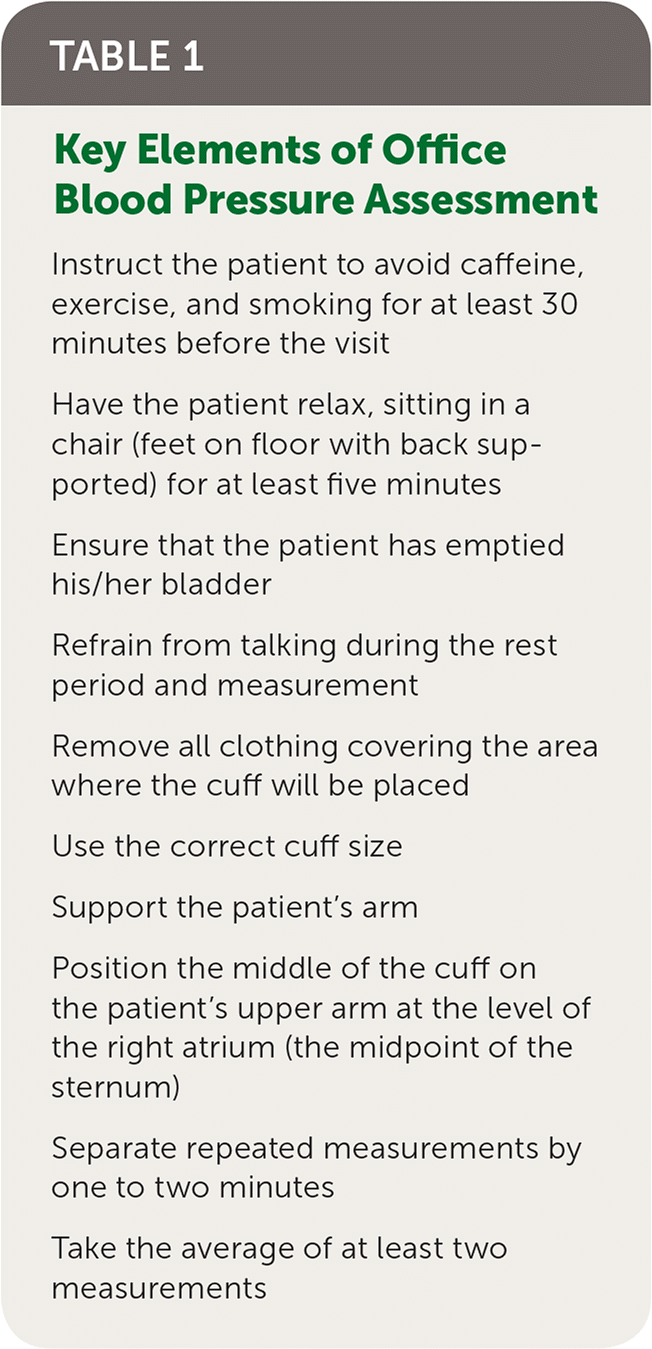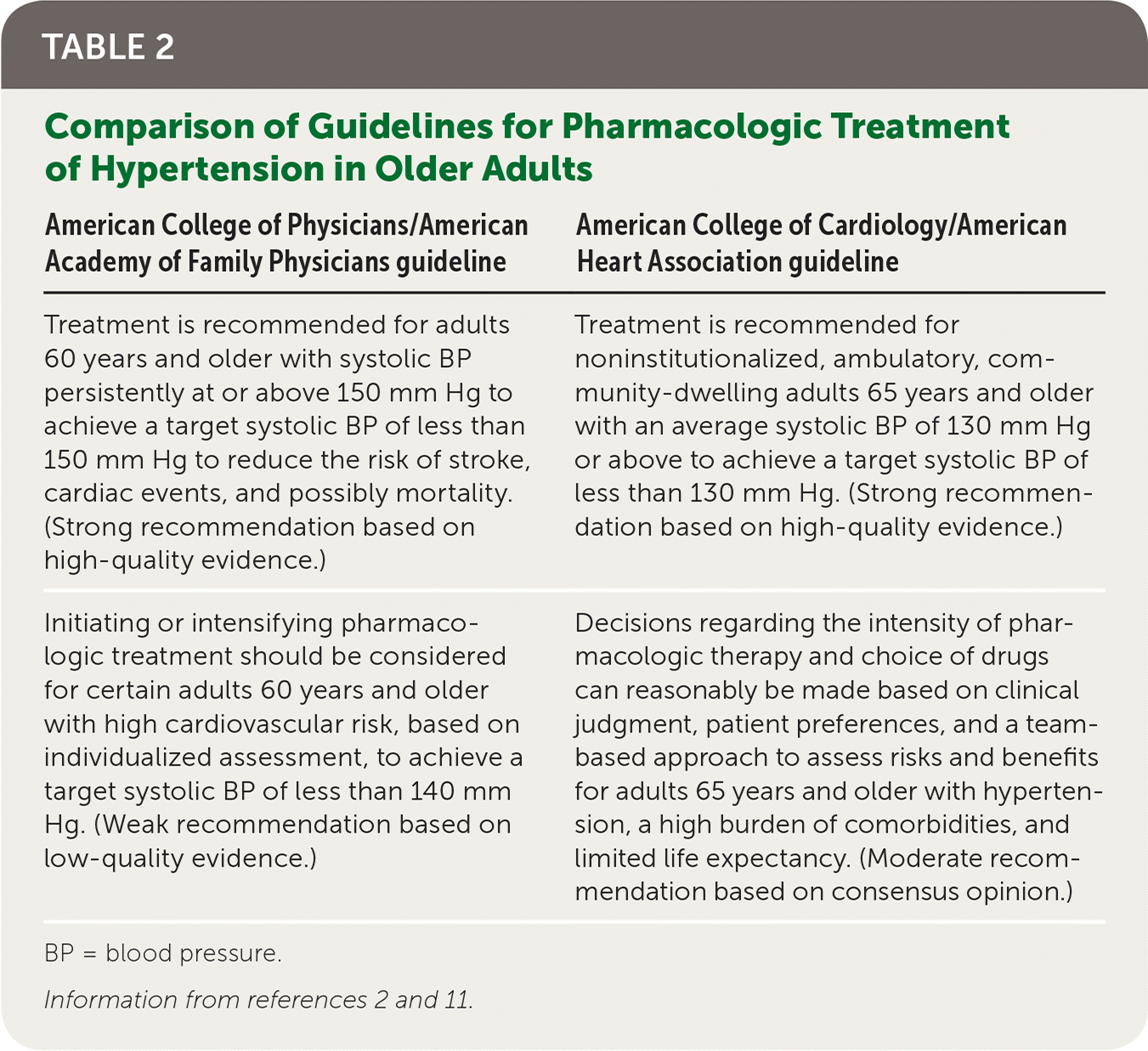
Am Fam Physician. 2018;97(6):372-373
Related Practice Guideline: High Blood Pressure: ACC/AHA Releases Updated Guideline.
Author disclosure: No relevant financial affiliations.
Redefining a cutoff point above which the value of a physiologic measurement reflects a disease has huge implications.1 The recently released guideline from the American College of Cardiology (ACC) and American Heart Association (AHA) on the prevention, detection, evaluation, and management of high blood pressure (BP) in adults,2 summarized in this issue of American Family Physician,3 lowers this cutoff from 140/90 to 130/80 mm Hg.
BP is a dynamic—not static—measurement, and varies based on when, where, and how it is measured. The new ACC/AHA guideline appropriately addresses BP measurement. Properly obtained measurements have been the standard in clinical trials, but require about 10 minutes and are not routinely obtained in the office setting (Table 1). Even a properly obtained office BP measurement is suboptimal for the diagnosis or management of hypertension; out-of-office readings using 12- to 24-hour ambulatory or home BP monitoring provide the best guidance.2,4 Enthusiasm is increasing for automated office BP meaurement,5 which duplicates the process described in Table 1 but does so without a clinician in the examination room. BP readings obtained with this method are 5 to 10 mm Hg lower than with techniques that involve a clinician, and they more closely reflect out-of-office readings. This approach was used in the SPRINT trial (Systolic Blood Pressure Intervention Trial)6 that was cited in the ACC/AHA guideline. Our current approach to routine office BP measurement should not be used to implement the targets recommended in this guideline.

| Instruct the patient to avoid caffeine, exercise, and smoking for at least 30 minutes before the visit |
| Have the patient relax, sitting in a chair (feet on floor with back supported) for at least five minutes |
| Ensure that the patient has emptied his/her bladder |
| Refrain from talking during the rest period and measurement |
| Remove all clothing covering the area where the cuff will be placed |
| Use the correct cuff size |
| Support the patient's arm |
| Position the middle of the cuff on the patient's upper arm at the level of the right atrium (the midpoint of the sternum) |
| Separate repeated measurements by one to two minutes |
| Take the average of at least two measurements |
What new evidence supported changing the BP cutoff for hypertension to 130/80 mm Hg? Nine trials contributed to the ACC/AHA meta-analysis on which the guideline was based.7 Trials selectively enrolled persons at high risk of cardiovascular disease (CVD), with follow-up ranging from 2.0 to 5.7 years. The two largest trials followed patients for an average of 3.3 and 4.7 years.6,8 No statistically significant benefit was found for all-cause mortality, CVD mortality, heart failure, or renal events when the lower BP cutoff was used, and the difference for fatal or nonfatal myocardial infarction was borderline nonsignificant. Only composite major CVD events (6.2% vs. 7.3%; relative risk = 0.84; number needed to treat = 91) and the combination of fatal and nonfatal stroke (2.4% vs. 2.9%; relative risk = 0.82; number needed to treat = 200) were significantly decreased when the lower cutoff was used. On the basis of these trials, as well as observational data linking BP to CVD risk, the ACC/AHA guideline defines hypertension as a BP of 130/80 mm Hg or greater. Underpinning this guideline is the belief that achieving this target BP will lower a person's risk of CVD events, including the large group of adults younger than 75 years who are at low to moderate risk of CVD and who were not included in the trials.
What does the ACC/AHA suggest we do with these patients now labeled with uncontrolled hypertension? Treat them. Institute lifestyle measures. Use pharmacotherapy. Intensify therapy for those already on medication. Recommendations for lifestyle modification alone apply only to adults younger than 65 years who have a 10-year CVD risk of less than 10%. The guideline is, however, vague about what to do for these patients when they return for follow-up in three to six months. Intensive behavioral counseling results in an average decrease in systolic BP of about 2 mm Hg at 12 to 24 months.9 The easy path will be to make the leap to medication, rather than leave this “disease” uncontrolled.
It is an overreach to take the results of existing trial data and label everyone who has a BP above 130/80 mm Hg as having uncontrolled hypertension, particularly when that label will be applied on the basis of the most recent routine office BP measurement. Much harm will come if this change is widely accepted and implemented, particularly if quality measures that echo this definition are put into place. Harms from the consequences of poor measurement, overmedication, and arbitrary quality measures can easily offset the small reduction in CVD events found in trials of high-risk persons. More than 90% of participants in the SPRINT trial whose BP targets were reduced were already receiving treatment; few data exist for initiating pharmacologic therapy at this new threshold. Notably, serious adverse events occurred in 38.3% and 37.1% of persons in the intervention and control groups, respectively; rates of hypotension, syncope, electrolyte abnormalities, acute kidney injury, and acute renal failure increased significantly in the intervention group.6
The American College of Physicians and the American Academy of Family Physicians (AAFP) offer thoughtful and balanced guidance that incorporates the results of these trials for adults 60 years and older10,11 (Table 22,11 ). The AAFP has declined to endorse the ACC/AHA guideline and continues to endorse the 2014 Evidence-Based Guideline for the Management of High Blood Pressure in Adults.12,13

| American College of Physicians/American Academy of Family Physicians guideline | American College of Cardiology/American Heart Association guideline |
|---|---|
| Treatment is recommended for adults 60 years and older with systolic BP persistently at or above 150 mm Hg to achieve a target systolic BP of less than 150 mm Hg to reduce the risk of stroke, cardiac events, and possibly mortality. (Strong recommendation based on high-quality evidence.) | Treatment is recommended for noninstitutionalized, ambulatory, community-dwelling adults 65 years and older with an average systolic BP of 130 mm Hg or above to achieve a target systolic BP of less than 130 mm Hg. (Strong recommendation based on high-quality evidence.) |
| Initiating or intensifying pharmacologic treatment should be considered for certain adults 60 years and older with high cardiovascular risk, based on individualized assessment, to achieve a target systolic BP of less than 140 mm Hg. (Weak recommendation based on low-quality evidence.) | Decisions regarding the intensity of pharmacologic therapy and choice of drugs can reasonably be made based on clinical judgment, patient preferences, and a team-based approach to assess risks and benefits for adults 65 years and older with hypertension, a high burden of comorbidities, and limited life expectancy. (Moderate recommendation based on consensus opinion.) |
In treating hypertension, we are treating a risk factor in asymptomatic patients to prevent disease, not treating a disease to relieve suffering. Most persons who receive preventive medication will not benefit, and many will be harmed. Choosing a threshold and target for treatment should be based on the science supporting CVD risk reduction, while considering the benefits and harms in individual patient circumstances and respecting patient choice.
Editor's Note: Dr. LeFevre was a member of the Eighth Joint National Committee panel that developed the 2014 Evidence-Based Guideline for the Management of High Blood Pressure in Adults, and currently serves on the Science Advisory Panel of the AAFP. He was not involved in the AAFP's decision to not endorse the ACC/AHA hypertension guideline.
